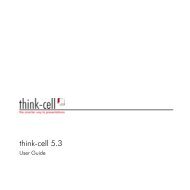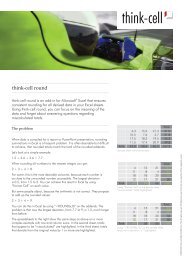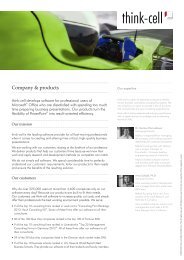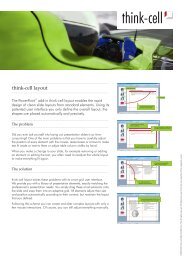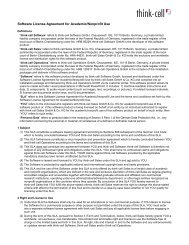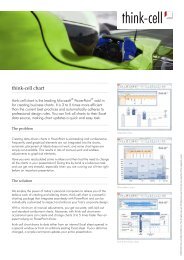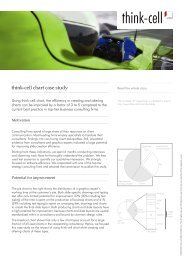think-cell technical report TC2003/01 A GUI-based Interaction ...
think-cell technical report TC2003/01 A GUI-based Interaction ...
think-cell technical report TC2003/01 A GUI-based Interaction ...
Create successful ePaper yourself
Turn your PDF publications into a flip-book with our unique Google optimized e-Paper software.
2.2 Quantitative Aspects FIELD STUDY<br />
ditional software-<strong>based</strong> support for custom drawings and text entry, the remaining<br />
fraction makes up for almost two-thirds (59.6 %) of the over-all PowerPoint inter-<br />
action time. In effect, this means that any efficiency gains in slide layout and chart<br />
design could have a major impact on the presentation creation workflow.<br />
2.2.4 Frequency of Different Chart Types<br />
The counting of slides and their composing elements was mainly focussed on chart<br />
types, including chart types that are not explicitly supported by Microsoft Power-<br />
Point. My findings (Fig. 6) make a strong point that a focussed improvement for<br />
only a few chart types could have a major impact on the over-all slide creation<br />
workflow: Only three different chart types make up for three-quarters (76 %) of<br />
all charts used throughout an average presentation. In addition, the three most<br />
frequently used chart types – bar charts, waterfall charts and column charts – bear<br />
great structural similarity, thus further encouraging a focussed approach.<br />
spent Frequency of Occurence Time<br />
Layout<br />
Text<br />
24% 13% 8% 5% 4% 3% 100%<br />
Chart 39%<br />
Waterfall Column Scatter Gantt Orga Line Others<br />
Bar<br />
19.9%<br />
Figure 6: Relative frequency of chart types in an average presentation (<strong>based</strong> on<br />
567 slides from 9 different presentations)<br />
Drawing<br />
2.2.5 Quantifying the Consultant’s Workflow<br />
Concluding my quantitative findings, this section presents some numbers that rep-<br />
resent the consultant’s point of view. The consultant’s workflow is explained in<br />
section 2.1.3 as part of my qualitative results.<br />
The origin of a presentation is a yellow pad scribble. There are roughly two<br />
categories of slides: (a) Visualization of numbers and (b) explanation of concepts.<br />
Slides from category (a) generally do not comprise much more than one or two<br />
charts. The charts are quickly sketched out and numbers are written down from an<br />
Excel sheet. An entire slide of this kind is created on yellow pad within 10 min on<br />
average and at the first attempt is usually suitable to be sent to the pool.<br />
On the other hand, conceptual slides (b) are much harder to create, because<br />
the consultant has to put down her ideas in telling geometric forms and concise<br />
23



